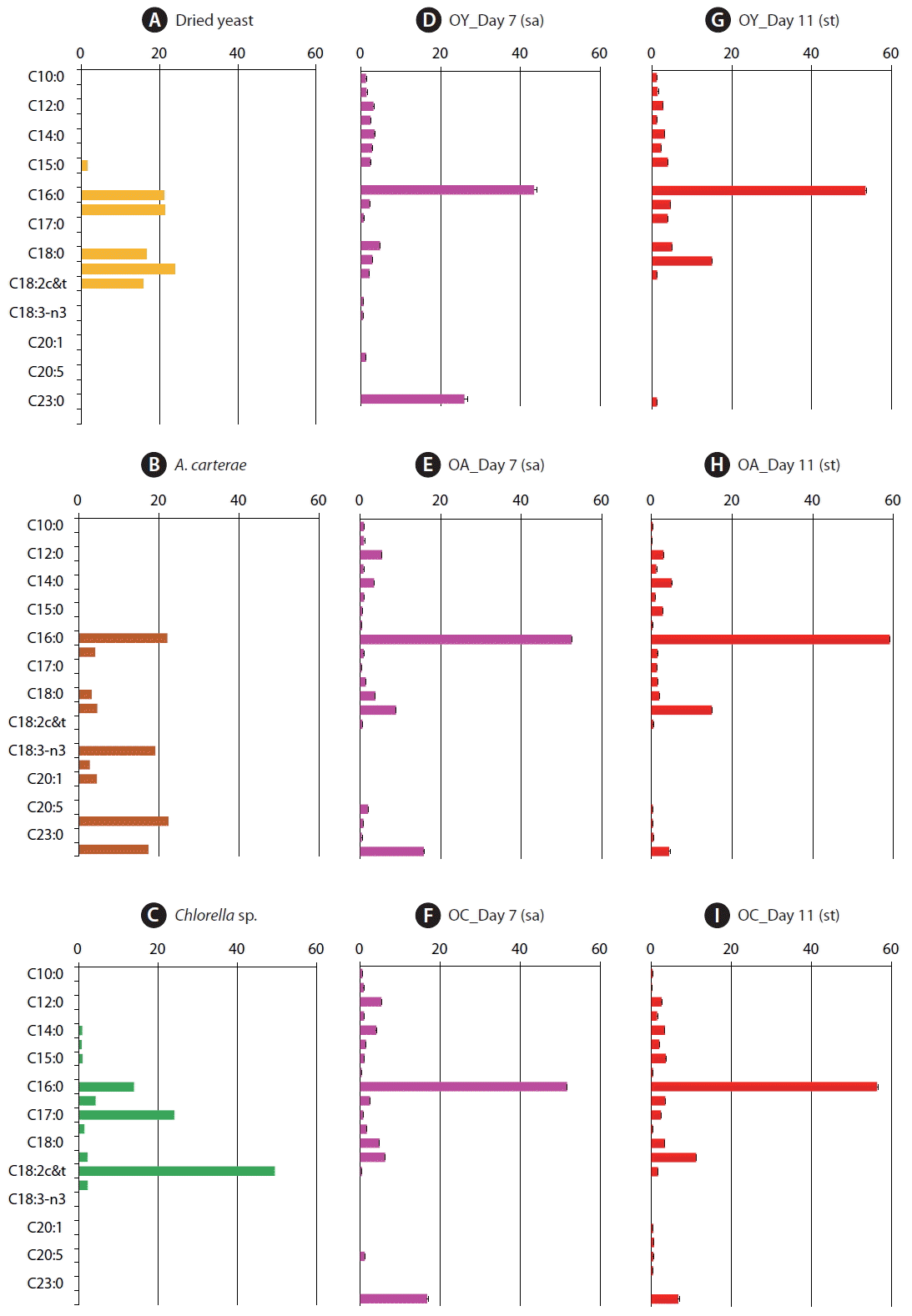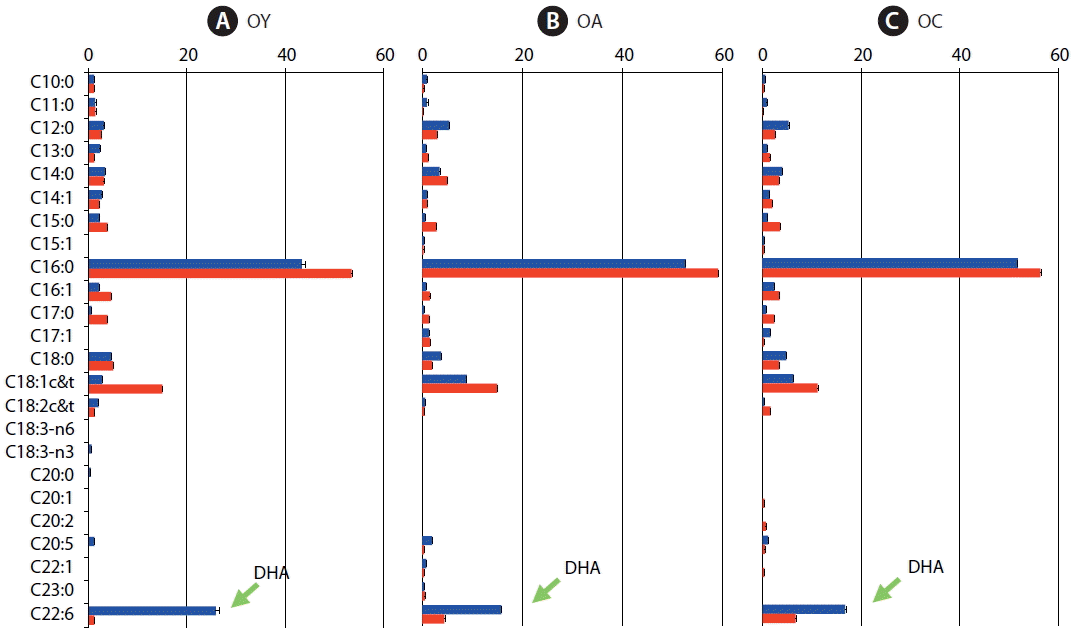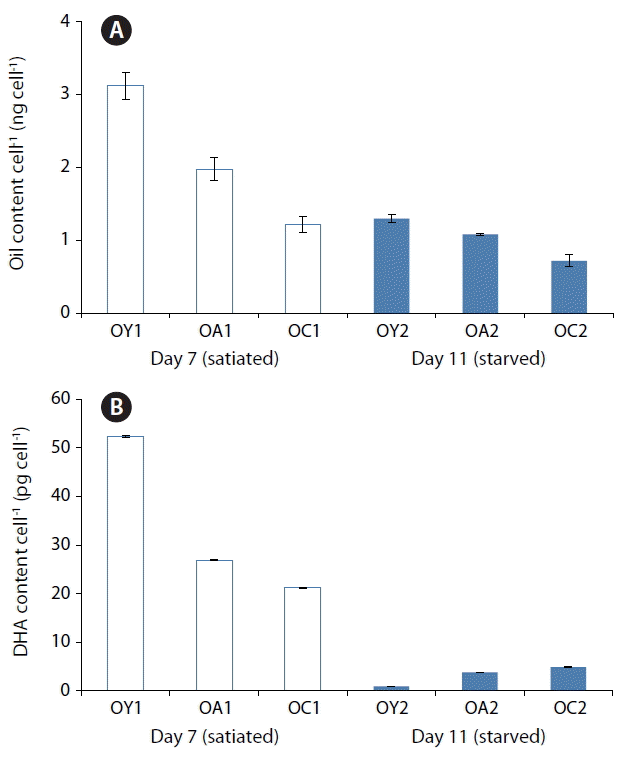Adolf, JE, Krupatkina, D, Bachvaroff, T & Place, AR 2007. Karlotoxin mediates grazing by
Oxyrrhis marina on strains of
Karlodinium veneficum. Harmful Algae. 6:400–412.

Arts, MT, Ackman, RG & Holub, BJ 2001. “Essential fatty acids” in aquatic ecosystems: a crucial link between diet and human health and evolution. Can J Fish Aquat Sci. 58:122–137.

Bligh, EG & Dyer, WJ 1959. A rapid method of total lipid extraction and purification. Can J Biochem Physiol. 37:911–917.


Burja, AM, Radianingtyas, H, Windust, A & Barrow, CJ 2006. Isolation and characterization of polyunsaturated fatty acid producing
Thraustochytrium species: screening of strains and optimization of omega-3 production. Appl Microbiol Biotechnol. 72:1161–1169.


Calder, PC & Yaqoob, P 2009. Understanding omega-3 polyunsaturated fatty acids. Postgrad Med. 121:148–157.

Coutteau, P, Brendonck, L, Lavens, P & Sorgeloos, P 1992. The use of manipulated baker’s yeast as an algal substitute for the laboratory culture of Anostraca. Hydrobiol. 234:25–32.

Droop, MR 1959. A note on some physical conditions for cultivating
Oxyrrhis marina. J Mar Biol Assoc U K. 38:599–604.

Jeong, HJ, Kang, H, Shim, JH, Park, JK, Kim, JS, Song, JY & Choi, H-J 2001. Interactions among the toxic dinoflagellate
Amphidinium carterae, the heterotrophic dinoflagellate
Oxyrrhis marina, and the calanoid copepods
Acartia spp. Mar Ecol Prog Ser. 218:77–86.

Jeong, HJ, Kim, JS, Yoo, YD, Kim, ST, Kim, TH, Park, MG, Lee, CH, Seong, KA, Kang, NA & Shim, JH 2003. Feeding by the heterotrophic dinoflagellate
Oxyrrhis marina on the red-tide raphidophyte
Heterosigma akashiwo: a potential biological method to control red tides. J Eukaryot Microbiol. 50:274–282.


Jeong, HJ, Lim, AS, Yoo, YD, Lee, MJ, Lee, KH, Jang, TY & Lee, K 2014. Feeding by heterotrophic dinoflagellates and ciliates on the free-living dinoflagellate
Symbiodinium sp. (Clade E). J Eukaryot Microbiol. 61:27–41.


Jeong, HJ, Seong, KA, Yoo, YD, Kim, TH, Kang, NS, Kim, S, Park, JY, Kim, JS, Kim, GH & Song, JY 2008. Feeding and grazing impact by small marine heterotrophic dinoflagellates on heterotrophic bacteria. J Eukaryot Microbiol. 55:271–288.


Jeong, HJ, Song, JE, Kang, NS, Kim, S, Yoo, YD & Park, JY 2007. Feeding by heterotrophic dinoflagellates on the common marine heterotrophic nanoflagellate
Cafeteria sp. Mar Ecol Prog Ser. 333:151–160.

Jeong, HJ, Yoo, YD, Kim, JS, Seong, KA, Kang, NS & Kim, TH 2010. Growth, feeding, and ecological roles of the mixotrophic and heterotrophic dinoflagellates in marine planktonic food webs. Ocean Sci J. 45:65–91.

Joordens, JCA, Kuipers, RS & Muskiet, FAJ 2007. Preformed dietary DHA: the answer to a scientific question may in practice become translated to its opposite. Am J Hum Biol. 19:582–584.


Kitajka, K, Sinclair, AJ, Weisinger, RS, Weisinger, HS, Mathai, M, Jayasooriya, AP, Halver, JE & Puskás, LG 2004. Effects of dietary omega-3 polyunsaturated fatty acids on brain gene expression. Proc Natl Acad Sci. 101:10931–10936.



Klein Breteler, WCM, Schogt, N, Baas, M, Schouten, S & Kraay, GW 1999. Trophic upgrading of food quality by protozoans enhancing copepod growth: role of essential lipids. Mar Biol. 135:191–198.

Lee, KH, Jeong, HJ, Yoon, EY, Jang, SH, Kim, HS & Yih, W 2014. Feeding by common heterotrophic dinoflagellates and a ciliate on the red-tide ciliate
Mesodinium rubrum. Algae. 29:153–163.

Liu, Y, Tang, J, Li, J, Daroch, M & Cheng, JJ 2014. Efficient production of triacylglycerols rich in docosahexaenoic acid (DHA) by osmo-heterotrophic marine protists. Appl Microbiol Biotechnol. 98:9643–9652.


Lund, ED, Chu, F-LE, Harvey, E & Adolf, R 2008. Mechanism(s) of long chain n-3 essential fatty acid production in two species of heterotrophic protists:
Oxyrrhis marina and
Gyrodinium domains. Mar Biol. 155:23–36.

Mendes, A, Reis, A, Vasconcelos, R, Guerra, P & da Silva, TL 2009.
Crypthecodinium cohnii with emphasis on DHA production: a review. J Appl Phycol. 21:199–214.

Park, J, Jeong, HJ, Yoon, EY & Moon, SJ 2016. Easy and rapid quantification of lipid contents of marine dinoflagellates using the sulpho-phospho-vanillin method. Algae. 31:391–401.

Roberts, EC, Wootton, EC, Davidson, K, Jeong, HJ, Lowe, CD & Montagnes, DJS 2010. Feeding in the dinoflagellate
Oxyrrhis marina: linking behaviour with mechanisms. J Plankton Res. 33:603–614.

Sijtsma, L & de Swaaf, ME 2004. Biotechnological production and applications of the ω-3 polyunsaturated fatty acid docosahexaenoic acid. Appl Microbiol Biotechnol. 64:146–153.


Simopoulos, AP 1991. Omega-3 fatty acids in health and disease and in growth and development. Am J Clin Nutr. 54:438–463.

Spolaore, P, Joannis-Cassan, C, Duran, E & Isambert, A 2006. Commercial applications of microalgae. J Biosci Bioeng. 101:87–96.


Sukhija, PS & Palmquist, DL 1988. Rapid method for determination of total fatty acid content and composition of feedstuffs and feces. J Agric Food Chem. 36:1202–1206.

Tang, KW & Taal, M 2005. Trophic modification of food quality by heterotrophic protists: species-specific effects on copepod egg production and egg hatching. J Exp Mar Biol Ecol. 318:85–98.

Veloza, AJ, Chu, FLE & Tang, KW 2006. Trophic modification of essential fatty acids by heterotrophic protists and its effects on the fatty acid composition of the copepod
Acartia tonsa. Mar Biol. 148:779–788.

Yang, Z, Jeong, HJ & Montagnes, DJS 2011. The role of
Oxyrrhis marina as a model prey: current work and future directions. J Plankton Res. 33:665–675.






